List of sunken battleships
From Wikipedia, the free encyclopedia
Sunken battleships are the wrecks of large capital ships built from the 1880s to the mid-20th century that were either destroyed in battle, mined, deliberately destroyed in a weapons test, or scuttled. The battleship, as the might of a nation personified in a warship, played a vital role in the prestige, diplomacy, and military strategies of 20th century nations. The importance placed on battleships also meant massive arms races between the great powers of the 20th century such as the United Kingdom, Germany, Japan, United States, France, Italy, Russia, and the Soviet Union.

The term "battleship" first entered common parlance to describe certain types of ironclad warships in the 1880s,[1] now referred to as pre-dreadnoughts. The commissioning and putting to sea of HMS Dreadnought, in part inspired by the results of the Battle of Tsushima in May 1905,[2] marked the dawn of a new era in naval warfare and defining an entire generation of warships: the battleships. This first generation, known as the "Dreadnoughts", came to be built in rapid succession in Europe, the Americas, and Japan with ever more tension growing between the major naval powers. However, despite the enormous sums of money and resources dedicated to the construction and maintenance of the increasing number of battleships in the world, they typically saw little combat. With the exception of the naval battles of the Russo-Japanese War and Jutland, which would be one of the last large-scale battles between capital ships,[3] no decisive naval battles between battleships were fought. When the First World War ended in 1918, much of the German High Seas Fleet was escorted to Scapa Flow, where almost all of the fleet was scuttled to prevent its being divided amongst the victorious Allies. Numerous other battleships were scuttled for similar reasoning.
Between the wars, the Washington Naval Treaty and the subsequent London Naval Treaty limited the tonnage and firepower of capital ships permitted to the navies of the world. The United Kingdom and the United States scrapped many of their aging dreadnoughts, while the Japanese began converting battlecruisers into fast battleships in the 1930s. In 1936, Italy and Japan refused to sign the Second London Naval Treaty and withdrew from the earlier treaties, prompting the United States and the United Kingdom to invoke an escalator clause in the treaty that allowed them to increase the displacement and armament of planned ships. The naval combat of World War II saw many battleships belonging to the various nations destroyed as air power began to be realized as being crucial to naval warfare, rather than massive capital ships. As the battleship began to fall out of favor, some captured capital ships were decommissioned, stripped, and deliberately sunk in nuclear weapons tests.
Losses
Summarize
Perspective
Much like battlecruisers, battleships typically sank with large loss of life if and when they were destroyed in battle. The first battleship to be sunk by gunfire alone,[4] the Russian battleship Oslyabya, sank with half of her crew at the Battle of Tsushima when the ship was pummeled by a seemingly endless stream of Japanese shells striking the ship repeatedly, killing crew with direct hits to several guns, the conning tower, and the water line or below it, which became the cause of the ship's sinking.[5][6] Battleships also proved to be very vulnerable to mines, as was evidenced in the Russo-Japanese War and both World Wars. After the Battle of Port Arthur,[7] a number of Russian and Japanese vessels were struck by mines and either sank or were scuttled to prevent their capture. A decade later, the Marine Nationale and Royal Navy lost three battleships, HMS Irresistible, HMS Ocean, and Bouvet, to Turkish mines in the waters of the Dardanelles. Torpedoes were also very capable of sinking battleships. On 21 November 1944, USS Sealion sank Kongō with over 1200 casualties.[8] HMS Barham was struck by three torpedoes fired from German submarine U-331.[a] Barham could not make an attempt to dodge the incoming torpedoes and sank with 862 fatalities as a result of several magazine explosions that occurred after she had initially been hit by U-331's torpedoes.[11]
Although mines and torpedoes constantly threatened the battleship's dominance, it was the refinement of aerial technology and tactics that led to the replacement of the battleship with the aircraft carrier as the most important naval vessel. Initially, the large scale use of aircraft in naval combat was underrated and the idea that they could destroy battleships was dismissed. Still, the United States and the Japanese Empire experimented with offensive roles for aircraft carriers in their fleets.[12] One pioneer of aviation in a naval role was US Army General Billy Mitchell, who commandeered SMS Ostfriesland for testing of his theory in July 1921. Though these tests did not impress his contemporaries, they forced the US Navy to begin diverting some of its budget towards researching the matter further.[13] The belief that the aircraft carrier was junior to the battleship began to evaporate when the Imperial Japanese Navy, in a surprise attack, nearly destroyed the United States Pacific Fleet while it was at anchor at Pearl Harbor on 7 December 1941.[14] The captain of the Bismarck, Ernst Lindemann, had almost dodged the Royal Navy until he was undone by British reconnaissance aircraft. Although almost every sea battle in World War II involved gunfire between surface warships to some degree, their time as the senior ship of a nation's fleet had run its course.[15]
Those battleships belonging to the Central Powers that survived World War I often did not survive its aftermath. The German High Seas Fleet was scuttled at Scapa Flow by its sailors in June 1919 following their surrender and internment the previous November.[16] On 1 November 1918, as the Austrian battleship Viribus Unitis was being transferred to the State of Slovenes, Croats and Serbs, she was mined and sunk at Pola by two Italian frogmen, Raffaele Paolucci and Raffaele Rossetti, who were unaware of the transfer.[17] On 27 November 1942 the Vichy French government scuttled the majority of the French fleet at Toulon.[18]
Sunk in combat
| Name | Navy | Casualties | Date sunk | Location | Condition | Relics | Image |
|---|---|---|---|---|---|---|---|
| Poltava[b] | — |
5 December 1904[19] | Port Arthur[19] | Scrapped[23] | — |
 | |
| Pobeda[c] | — |
7 December 1904[26] | Port Arthur[19] | Scrapped[26] | — |
 | |
| Oslyabya | 470–514 killed[d] | 27 May 1905[4] | Tsushima Strait[28] | Unknown | — |
 | |
| Imperator Aleksandr III | Lost with all hands[29] | 27 May 1905[30] | Tsushima Strait[31] | Unknown | — |
 | |
| Borodino | 854 killed, 1 captured[31] | 27 May 1905[32] | Tsushima Strait[30] | Unknown | — |
 | |
| Knyaz Suvorov | 908 killed, 20 captured[29] | 27 May 1905[33] | Tsushima Strait[30] | Unknown | — |
 | |
| Navarin | 741 killed, 1 captured[34][35] | 28 May 1905[36] | Tsushima Strait[35] | Unknown | — |
 | |
| Sissoi Veliky | 47 killed, 613 captured[37] | 28 May 1905[38] | Tsushima Strait[30] | Unknown | — |
 | |
| HMS Formidable | 547 killed[39] | 1 January 1915[39] | 50°13′N 3°4′W Off Portland Bill, English Channel[39] | Unknown | — |
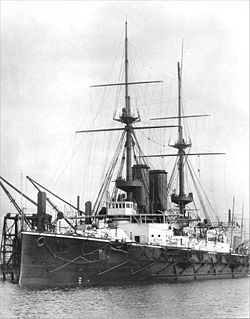 | |
| HMS Irresistible | 150 killed[40] | 18 March 1915[41] | Dardanelles[12] | Unknown | — |
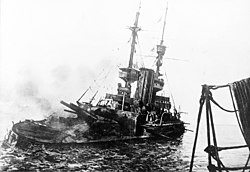 | |
| HMS Goliath | 570 killed[42] | 13 May 1915[42] | Dardanelles[42] | Unknown | — |
 | |
| HMS Triumph[e] | 78 killed[44] | 25 May 1915[44] | Near Gaba Tepe, Gallipoli Peninsula[44] | Unknown | — |
 | |
| HMS Majestic | 40–49 killed[f] | 27 May 1915[46] | 40°02′30″N 26°11′02″E Cape Helles, Gallipoli Peninsula[46] | Unknown | — |
 | |
| Barbaros Hayreddin[g] | 258 killed[48] | 8 August 1915[49] | Dardanelles[50] | Unknown | — |
 | |
| SMS Pommern | Lost with all hands[51] | 1 June 1916[51] | North Sea[52] | Unknown | — |
||
| Suffren | Lost with all hands[53] | 26 November 1916[53] | 39°10′N 10°48′W Off Lisbon, Portugal[53] | Unknown | — |
 | |
| Gaulois | Four killed[54] | 27 December 1916[55] | 36°15′N 23°42′E Off Cape Maleas, Aegean Sea[54] | Unknown | — |
 | |
| HMS Cornwallis | 15 killed[56] | 9 January 1917[57] | 35°06′N 15°11′E Off Malta[57][58] | Unknown | — |
 | |
| Danton | 296 killed[59] | 19 March 1917[59] | 38°45′35″N 8°3′30″E Mediterranean Sea[59] | Upright under 1,000 meters (3,300 ft) of water.[59] | — |
 | |
| SMS Szent István | 89 killed[60] | 10 June 1918[60] | 44°12′07″N 14°27′05″E Premuda, Adriatic Sea | Capsized under 66 meters (217 ft) of water.[61] | — |
 | |
| SMS Viribus Unitis | 300 killed[62] | 1 November 1918[62] | 44°52′9″N 13°49′9″E Pula, Croatia[62] | Unknown | — |
 | |
| HMS Britannia | 50 killed, 80 injured[63] | 9 November 1918[64] | 35°53′N 5°53′W Off Cape Trafalgar, Strait of Gibraltar[64] | Unknown | — |
 | |
| HMS Royal Oak | 833 killed[65] | 14 October 1939[66] | 58°55′N 2°59′W Scapa Flow[67] | Capsized under 33 meters (108 ft) of water.[68] | Royal Oak's bell is the centerpiece to a memorial to those who died aboard Royal Oak at St Magnus' Cathedral in Kirkwall.[69] | 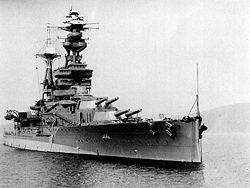 | |
| Bretagne | 977 killed[70] | 3 July 1940[71] | Mers-el-Kébir, Algeria[71] | Scrapped[72] | — |
 | |
| Kilkis[h] | — |
23 April 1941[74] | Salamis Naval Base, near Salamis[74] | Scrapped[75] | — |
 | |
| Lemnos[i] | — |
23 April 1941[74] | Salamis Naval Base, near Salamis[74] | Scrapped[77] | — |
 | |
| Bismarck | 2086 killed, 115 captured.[78] | 27 May 1941[79] | 48°10′N 16°12′W 650 kilometers (400 mi) from Brest, North Atlantic[80] | Bismarck was found in great condition. She sank after being heavily bombarded by British ships. Bismarck sank stern first in her plunge to the ocean floor. Her bridge and stern ripped away as she spiraled downwards, and as she settled on the side of an extinct underwater volcano, the down blast from all the water she displaced hit her and caused her to slide down the volcano on a water avalanche of sorts. Soon a mud slide occurred due to the shifting of the soil caused by the massive ship and it began to carry her down. She finally settled upright under 4,791 meters (15,719 ft) of water. She slid half a mile.[80] | — |
 | |
| Marat[j] | 326 killed[83] | 23 September 1941[83] | Leningrad[83] | Scrapped[82] | — |
 | |
| HMS Barham | 862 killed[84][85] | 25 November 1941[86] | 32°34′N 26°24′E Off Egypt[84] | Unknown | — |
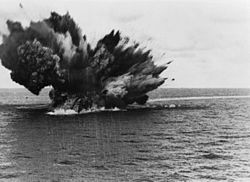 | |
| USS Arizona | 1177 killed[87] | 7 December 1941[88] | 21°21′53″N 157°57′0″W Pearl Harbor[87] | Heavily damaged as a result of the attack on Pearl Harbor. After being struck off the Naval Vessel Register on 1 December 1942, Arizona was found to be in such terrible condition that she could not be made serviceable again even after salvaging.[89] Arizona's surviving superstructure was removed in 1942, followed by her main armament over the next year and a half.[90] | The amidships section had served as a ceremonial platform on the wreck but was cut away to make room for today's overlying memorial. One of the ship's bells is at the University of Arizona,[91] an anchor and a restored gun barrel is located at the Wesley Bolin Memorial Plaza, and several of her guns were later used aboard USS Nevada.[92] Other artifacts from the ship, such as items from the ship's silver service, are on permanent exhibit in the Arizona State Capitol Museum.[93] |  | |
| USS Utah | 64 killed[94] | 7 December 1941[94] | 21°22′7″N 157°57′44″W Pearl Harbor | Utah capsized during the attack, and was partially salvaged but not recovered.[95] Utah's wreck is almost completely submerged, with a small amount of highly corroded superstructure visible above the surface.[94] | In 1972, a memorial consisting of a 70 ft (21 m) walkway from nearby Ford Island that terminates in a platform with a flagpole and a plaque.[96] Other relics of the Utah are preserved at the Utah State Capitol and are regularly on display.[97] |  | |
| HMS Prince of Wales | 327 killed[98] | 10 December 1941[99] | 3°33′36″N 104°28′42″E South China Sea[100] | Capsized under 71 meters (233 ft) of water. Reported to have been heavily salvaged.[100] | Prince of Wale's bell was recovered, restored, and displayed in the Merseyside Maritime Museum in Liverpool.[100] |  | |
| Asahi | 16 killed[101] | 25 May 1942[102] | 10°N 110°E 100 miles (160 km) from Cape Paderan, Vietnam[102] | Unknown | — |
 | |
| Hiei | 188 killed[103] | 13 November 1942[103] | 9°N 159°E Off Guadalcanal[104] | Capsized under 900 meters (3,000 ft) of water.[105] | — |
 | |
| Kirishima | 212 killed[106] | 15 November 1942[106] | Off Guadalcanal[104] | Capsized under 1,100 meters (3,600 ft) of water.[107] | — |
 | |
| Roma | 1393 killed[108] | 9 September 1943[109] | 41°9′28″N 8°17′35″E 30 kilometers (19 mi) north of Sardinia | Capsized and blown in half under 1,000 meters (3,300 ft).[110] | — |
 | |
| Scharnhorst | 1932 killed, 36 captured[111] | 26 December 1943[112] | 72°16′N 28°41′E near the Norwegian North Cape[113] | Capsized under 290 meters (950 ft).[114] | — |
 | |
| Strasbourg | — |
18 August 1944[115] | Bay of Lazaret[115] | Scrapped[115] | — |
 | |
| Jean Bart[k] | — |
28 August 1944[117] | Toulon, France[117] | Scrapped[118] | — |
 | |
| Musashi | 1023 killed[119] | 24 October 1944[120] | 13°7′N 122°32′E Sibuyan Sea[121] | Heavily damaged and in multiple pieces under 1,000 meters (3,300 ft) of water.[122][123] | — |
 | |
| Fusō | 1620 killed[124] | 25 October 1944[124] | Surigao Strait[124] | Capsized 185 meters (607 ft) of water with pagoda mast snapped off.[125] | — |
 | |
| Yamashiro | 1626 killed[126] | 25 October 1944[127] | Surigao Strait[127] | Capsized in 191 meters (627 ft) of water with bow folded back over the keel of the rest of the hull, and engine room collapsed.[128] | — |
 | |
| Tirpitz | 950–1204 killed[l] | 12 November 1944[113] | 69°38′50″N 18°48′30″E Håkøybotn Bay, Norway[134] | Somewhat salvaged after the Second World War.[131] | — |
 | |
| Kongō | 1250 killed[106] | 21 November 1944[135] | 26°9′N 121°23′E Taiwan Strait[135] | Unknown | — |
 | |
| Conte di Cavour | — |
23 February 1945[136] | Taranto Harbor[137] | Scrapped[138] | — |
 | |
| Yamato | 3055 killed[139] | 7 April 1945[140] | 30°22′N 128°4′E East China Sea[141] | Broken in half under 340 meters (1,120 ft) of water.[141] | — |
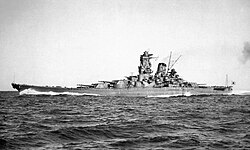 | |
| Haruna | 65 killed[106] | 24 July 1945[106] | Kure, Japan[106] | Scrapped[106] | — |
 | |
| Settsu | — |
29 July 1945[142] | Kure, Japan[142] | Scrapped[142] | — |
 | |
| Ise | 50 killed[143] | 28 July 1945[143] | Kure, Japan[143] | Scrapped[143] | — |
 | |
| Hyūga | 200+ killed[144] | 1 August 1945[144] | 34°10′N 132°33′E Kure, Japan[144] | Scrapped[144] | — |
 |
Converted battleships
| Name | Navy | Casualties | Date sunk | Location | Condition | Image |
|---|---|---|---|---|---|---|
| Kaga | 811 killed[145] | 4 June 1942[146] | 30°23′N 179°17′W | Unknown |  | |
| HMS Eagle | 131 killed[147] | 11 August 1942[147] | 38°3′0″N 3°1′12″E near Majorca[147] | Unknown |  | |
| Shinano | 1435 killed[148] | 29 November 1944[148] | 32°7′N 137°4′E 105 kilometers (65 mi) south of mainland Japan.[148] | Unknown |  |
Lost at sea
| Name | Navy | Casualties | Date sunk | Location | Condition | Image |
|---|---|---|---|---|---|---|
| Petropavlovsk | 679 killed[149] | 13 April 1904[150] | Yellow Sea[151] | Unknown |  | |
| Hatsuse | 496 killed[152] | 15 May 1904[153] | 38°37′N 121°20′E Yellow Sea[154] | Unknown |  | |
| Yashima | — |
15 May 1904[155] | 38°34′N 121°40′E Yellow Sea[156] | Unknown |  | |
| HMS Montagu | — |
30 May 1906[157] | Lundy Island, England[157] | Almost entirely salvaged.[158] |  | |
| Iéna | 120 killed[159] | 12 March 1907[160] | Toulon, France[160] | Scrapped[161] |  | |
| Liberté | 250 killed[162] | 25 September 1911[162] | Toulon, France[163] | Scrapped[163] |  | |
| HMS Audacious | One killed[164] | 27 October 1914[164] | 55°32′16″N 7°24′33″W 39 kilometers (24 mi) of Tory Island[165] | Capsized under 64 meters (210 ft) of water.[166][165] |  | |
| HMS Bulwark | 736 killed[167] | 26 November 1914[167] | 51°25′N 0°39′E Off Sheerness, England[167] | Unknown |  | |
| HMS Ocean | Unknown | 18 March 1915[168] | Dardanelles[168] | Unknown |  | |
| Bouvet | 639 killed[55] | 18 March 1915[169] | 40°01′15″N 26°16′30″E Dardanelles[169] | Unknown |  | |
| Benedetto Brin | 454 killed[170] | 27 September 1915[170] | Brindisi, Italy[170] | Unknown |  | |
| HMS King Edward VII | — |
6 January 1916[171] | Off Cape Wrath, Scotland.[171] | Capsized under 108 meters (354 ft) of water.[172] |  | |
| HMS Russell | 125 killed[173] | 27 April 1916[174] | 35°54′N 14°36′E Off Valletta, Malta[173][174] | Capsized under 110 meters (360 ft) of water.[173][174] |  | |
| Leonardo da Vinci | 448 killed[175] | 2 August 1916[176] | Taranto, Italy[177] | Scrapped[176][178] |  | |
| Imperatritsa Mariya | 228 killed[179] | 20 October 1916[180] | Sevastopol, Ukraine[180] | Scrapped[181] |  | |
| Regina Margherita | 675 killed[182] | 12 December 1916[183] | Off Valona, Albania[183] | Laying on her starboard side under 68 meters (223 ft).[184] |  | |
| Peresvet[m] | 116–167 killed[n] | 4 January 1917[187] | Off Port Said, Egypt[187] | Unknown |  | |
| HMS Vanguard | 843 killed[189] | 9 July 1917[190] | 58°51′24″N 3°6′22″W Scapa Flow[190] | Unknown, rests under 14.2 meters (47 ft) of water.[190] |  | |
| Kawachi | 600–700 killed[o] | 2 July 1918[193] | 34°0′N 131°36′E | Partially salvaged.[195] | 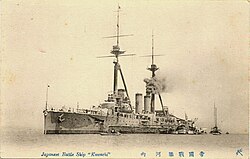 | |
| HMS Prince George[p] | — |
30 December 1921[196] | 52°44′5″N 4°38′23″E Off Camperduin, the Netherlands[196] | Upright and visible from shore, partially scrapped.[196] |  | |
| France | Three killed[197] | 26 August 1922[197] | 47°27′6″N 3°2′0″W Quiberon Bay, France[197] | Unknown |  | |
| España | — |
26 August 1923[198] | Cape Tres Forcas, Morocco[198] | Somewhat salvaged, including a 305 mm (12.0 in) and a 102 mm (4.0 in) gun, but mostly destroyed by severe storms.[198] |  | |
| Alfonso XIII[q] | Five killed[200] | 30 April 1937[200] | 43°31′26″N 3°40′44″W Off Santander, Spain[200] | Unknown |  | |
| Jaime I | — |
17 June 1937[201] | Cartagena, Spain | Scrapped[202] |  | |
| Ilmarinen | 271 killed[203] | 13 September 1941[203] | Gulf of Finland[203] | Capsized upside down under 80 meters (262 ft), declared as a war grave.[203] |  | |
| Mutsu | 1121 killed[204] | 8 June 1943[205] | 33°58′N 132°24′E Seto Inland Sea[205] | Due to salvaging efforts that ceased in the 1990s,[205] the only major piece of the wreckage that remains is a 35-meter (115 ft) stretch of the hull from the bridge to turret No. 1 at a depth of about 12 meters (39 ft).[206] |  | |
| Schlesien | — |
3 May 1945[207] | Off Zinnowitz, Germany[207] | Scrapped[208][207] |  | |
| USS Oklahoma | — |
17 May 1947[209] | Unknown, northeast of Hawaii[209] | Capsized in Pearl Harbor Attack. Salvaged. |  | |
| São Paulo | — |
November 1951[210] | Unknown | Unknown |  | |
| Novorossiysk[r] | 608 killed[212] | 29 October 1955 | 44°37′7″N 33°32′8″E Sevastopol, Ukraine | Scrapped[213] |  |
Scuttled battleships
| Name | Navy | Casualties | Date sunk | Location | Condition | Relics | Image |
|---|---|---|---|---|---|---|---|
| Sevastopol | 11 killed[214] | 2 January 1905[215] | Port Arthur[214] | Unknown | — |
 | |
| HMS Hood | — |
4 November 1914[216] | 50°34′9″N 2°25′16″W Portland Harbour[216] | — |
— |
 | |
| Masséna | — |
9 November 1915[217] | Cape Helles, Gallipoli[217] | Unknown | — |
 | |
| Slava | Three killed[218] | 17 October 1917[219] | Moon Sound, Estonia[219] | Scrapped[220] | — |
 | |
| Imperatritsa Ekaterina Velikaya[s] | — |
18 June 1918[181] | 44°42′23″N 37°48′43″E Novorossiysk, Russia[181] | Unknown | — |
 | |
| SMS König | — |
21 June 1919[223] | Gutter Sound, Scapa Flow[223] | Capsized under about 35 meters (115 ft) of water.[224] Somewhat damaged by metal scavenging.[225] | — |
 | |
| Kronprinz Wilhelm | One killed[226] | 21 June 1919[226] | Gutter Sound, Scapa Flow[226] | Capsized under about 45 meters (148 ft) of water.[227] | — |
 | |
| SMS Markgraf | Two killed[228] | 21 June 1919[228] | Gutter Sound, Scapa Flow[228] | Capsized under about 45 meters (148 ft) of water.[229] | — |
 | |
| SMS Kaiser | — |
21 June 1919[230] | Gutter Sound, Scapa Flow[230] | Scrapped[230] | — |
 | |
| SMS Friedrich der Grosse | — |
21 June 1919[230] | Gutter Sound, Scapa Flow[230] | Scrapped[230] | Friedrich der Grosse's bell was returned to the Federal Republic of Germany and today is on display at the German Navy sea base at Glücksburg.[230] |  | |
| SMS Kaiserin | — |
21 June 1919[230] | Gutter Sound, Scapa Flow[230] | Scrapped[230] | — |
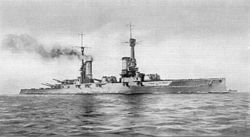 | |
| SMS Prinzregent Luitpold | — |
21 June 1919[230] | Gutter Sound, Scapa Flow[230] | Scrapped[230] | — |
 | |
| SMS König Albert | — |
21 June 1919[230] | Gutter Sound, Scapa Flow[230] | Scrapped[230] | — |
 | |
| SMS Grosser Kurfürst | — |
21 June 1919[223] | Gutter Sound, Scapa Flow[223] | Scrapped[223] | Grosser Kurfürst's bell was purchased at auction by the National Museum of the Royal Navy, Portsmouth, Hampshire.[231] |  | |
| SMS Bayern | — |
21 June 1919[232] | Gutter Sound, Scapa Flow[232] | Scrapped[232] | Bayern's bell is on display at the Kiel Fördeklub.[232] |  | |
| Rostislav | — |
November 1920[233] | 45°25′0″N 36°37′43″E Strait of Kerch[233] | Partially salvaged, reported to be extant albeit sinking into silt.[234] | — |
 | |
| Dunkerque | — |
27 November 1942[235] | Toulon, France[235] | Scrapped[235] | — |
||
| Provence | 27 November 1942[72] | Toulon, France[72] | Scrapped[72] | — |
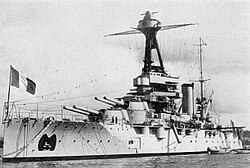 | ||
| HMS Centurion | — |
9 June 1944[236] | Off Normandy[236] | Unknown | HMS Centurion's badge is on display at Shugborough Hall.[237] |  | |
| Courbet | — |
9 June 1944[238] | Off Sword Beach, Normandy[238] | Scrapped[238] | — |
 | |
| Schleswig-Holstein | — |
21 March 1945[239] | Off Osmussaar, Gulf of Finland[240] | Wreckage buried in 1966.[241] | Schleswig-Holstein's bell is on display in the Military History Museum of the Bundeswehr in Dresden as of 1990.[208] |  | |
| Gneisenau | — |
27 March 1945[242][243] | Gotenhafen (Gdynia), Poland[243] | Scrapped[244] | Her aft main turret was removed and placed at Austrått Fort, near Trondheim, as the coastal gun "Orlandert."[243] |  | |
| Zähringen | — |
26 March 1945[245] | Gotenhafen (Gdynia), Poland[245] | Scrapped[245] | — |
 |
Expended as targets
See also
Notes
References
External links
Wikiwand - on
Seamless Wikipedia browsing. On steroids.























